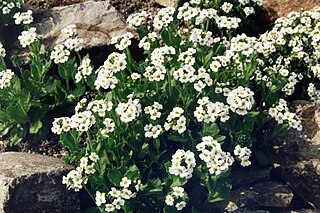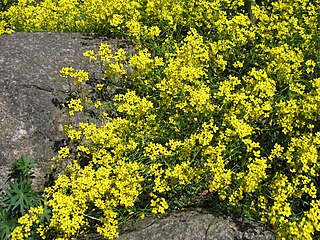
Alnus incana, the grey alder, tag alder or speckled alder, is a species of multi-stemmed, shrubby tree in the birch family, with a wide range across the cooler parts of the Northern Hemisphere. Tolerant of wetter soils, it can slowly spread with runners and is a common sight in swamps and wetlands.
There are over 190 vascular plant species on the Norwegian Arctic archipelago of Svalbard. This figure does not include algae, mosses, and lichens, which are non-vascular plants. For an island so far north, this number of species constitutes an astonishing variety of plant life. Because of the harsh climate and the short growing season, all the plants are slow growing. They seldom grow higher than 10 cm (4 in)

An Arctic–alpine taxon is one whose natural distribution includes the Arctic and more southerly mountain ranges, particularly the Alps. The presence of identical or similar taxa in both the tundra of the far north, and high mountain ranges much further south is testament to the similar environmental conditions found in the two locations. Arctic–alpine plants, for instance, must be adapted to the low temperatures, extremes of temperature, strong winds and short growing season; they are therefore typically low-growing and often form mats or cushions to reduce water loss through evapotranspiration.

Draba is a large genus of flowering plants in the family Brassicaceae, commonly known as whitlow-grasses.

Draba aizoides is a species of flowering plant in the family Brassicaceae, known as yellow whitlow-grass. It is native to Europe where it is found on limestone rocks and walls. In the British Isles it is found only on the Gower Peninsula in Wales.
NVC community CG10 is one of the calcicolous grassland communities in the British National Vegetation Classification system. Of the upland group of calcicolous grasslands, it is the only one with a short sward associated with heavy grazing.

Draba verna, common whitlowgrass, is a species of plant in the cabbage family. It is a small spring-flowering annual which is widely dispersed around the world, and which is found on walls, pavements and patches of bare ground. It has a complex taxonomy which is not yet fully elucidated.
Davidiella tassiana is a fungal plant pathogen infecting several hosts, including Iris barnumiae subsp. demawendica in Iran.
Draba splendens is a species of flowering plant in the family Brassicaceae. It is found only in Ecuador. Its natural habitats are subtropical or tropical high-altitude grassland and rocky areas. It is threatened by habitat loss.

The Circumboreal Region in phytogeography is a floristic region within the Holarctic Kingdom in Eurasia and North America, as delineated by such geobotanists as Josias Braun-Blanquet and Armen Takhtajan.

Oenothera macrocarpa, the bigfruit evening primrose, Ozark sundrops, Missouri evening primrose, or Missouri primrose, is a species of flowering plant in the evening primrose family Onagraceae, native to northeast Mexico and the south-central United States, where it is found in calcareous prairies and limestone outcrops.

Draba fladnizensis is a species of plant in the family Brassicaceae known by the common names arctic draba, Austrian draba, and white arctic whitlow-grass. It has a circumpolar distribution, occurring throughout the northern latitudes of the Northern Hemisphere. It is present in Europe, Asia, and North America from Alaska across northern Canada to Greenland. Its distribution extends south through the higher elevations in the Rocky Mountains to Colorado and Utah. It is common and widespread in the Canadian Arctic Archipelago, occurring on several Arctic islands including Baffin, Devon, and Ellesmere Islands. It is named after the Austrian village of Flattnitz, in the Gurktaler Alpen.
Physaria fremontii is a species of flowering plant in the family Brassicaceae known by the common name Fremont's bladderpod. It is endemic to Wyoming in the United States, where it occurs only in and around the Wind River Range in Fremont County.

Melaleuca incana, commonly known as grey honey-myrtle, is a plant in the myrtle family, Myrtaceae and is endemic to the south-west of Western Australia and is naturalised in the south of Victoria in Australia. It is commonly grown as a garden plant and produces large numbers of white or creamy yellow flowers, sometimes highly scented, in spring.

Draba sibirica is a species of flowering plant belonging to the family Brassicaceae.

Draba corymbosa is a species of flowering plant belonging to the family Brassicaceae.

Draba nemorosa is a species of flowering plant belonging to the family Brassicaceae.

Veronica incana, the silver speedwell, is a species of flowering plant in the family Plantaginaceae. It is native to parts of Eastern Europe and Russia, all of Siberia, Mongolia, and northern China, and has been introduced to Czechoslovakia. A number of authorities consider it to be a subspecies of the spiked speedwell Veronica spicata; Veronica spicata subsp. incana. It is a parent of the hybrids Veronica × czemalensis and Veronica × grisea.













